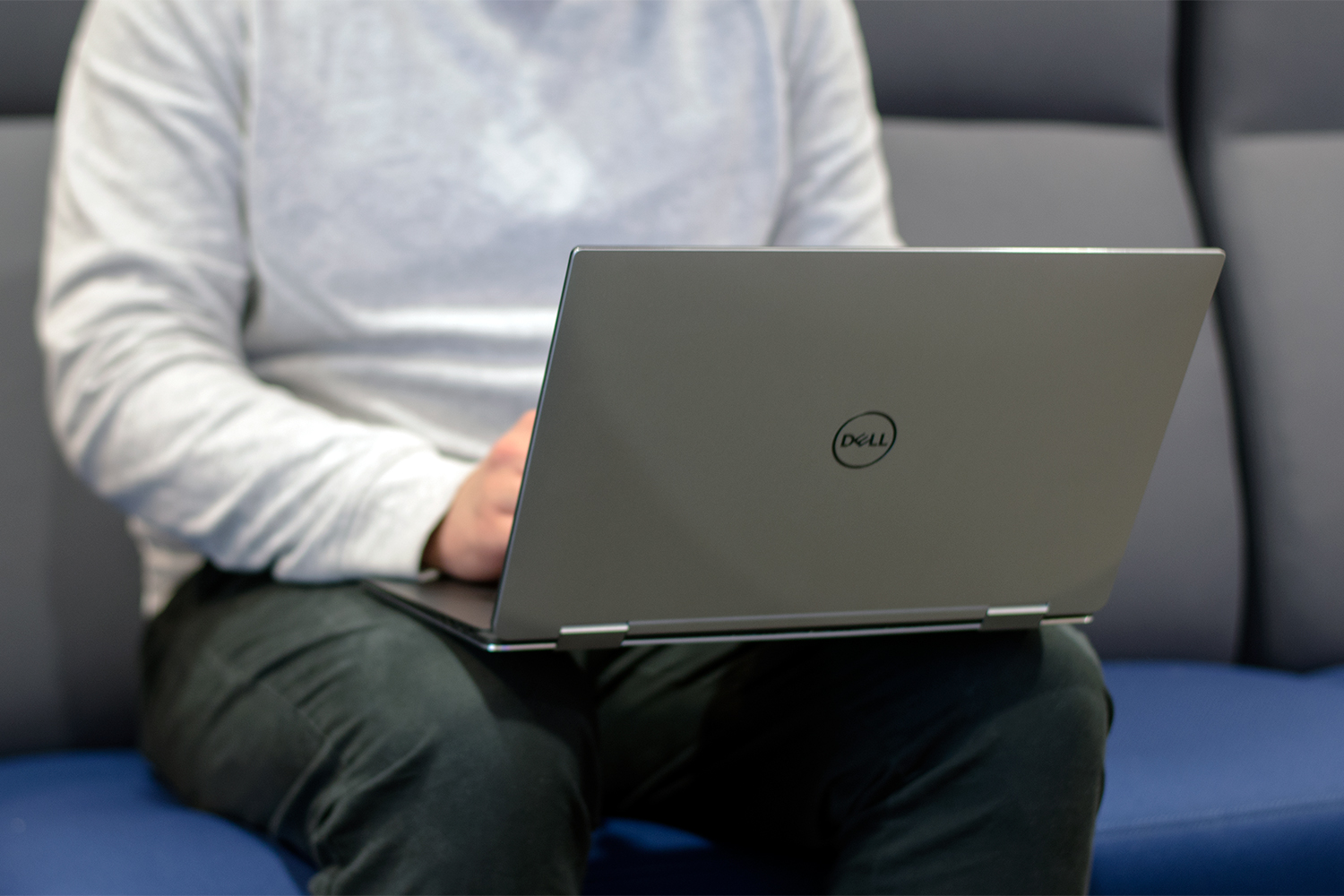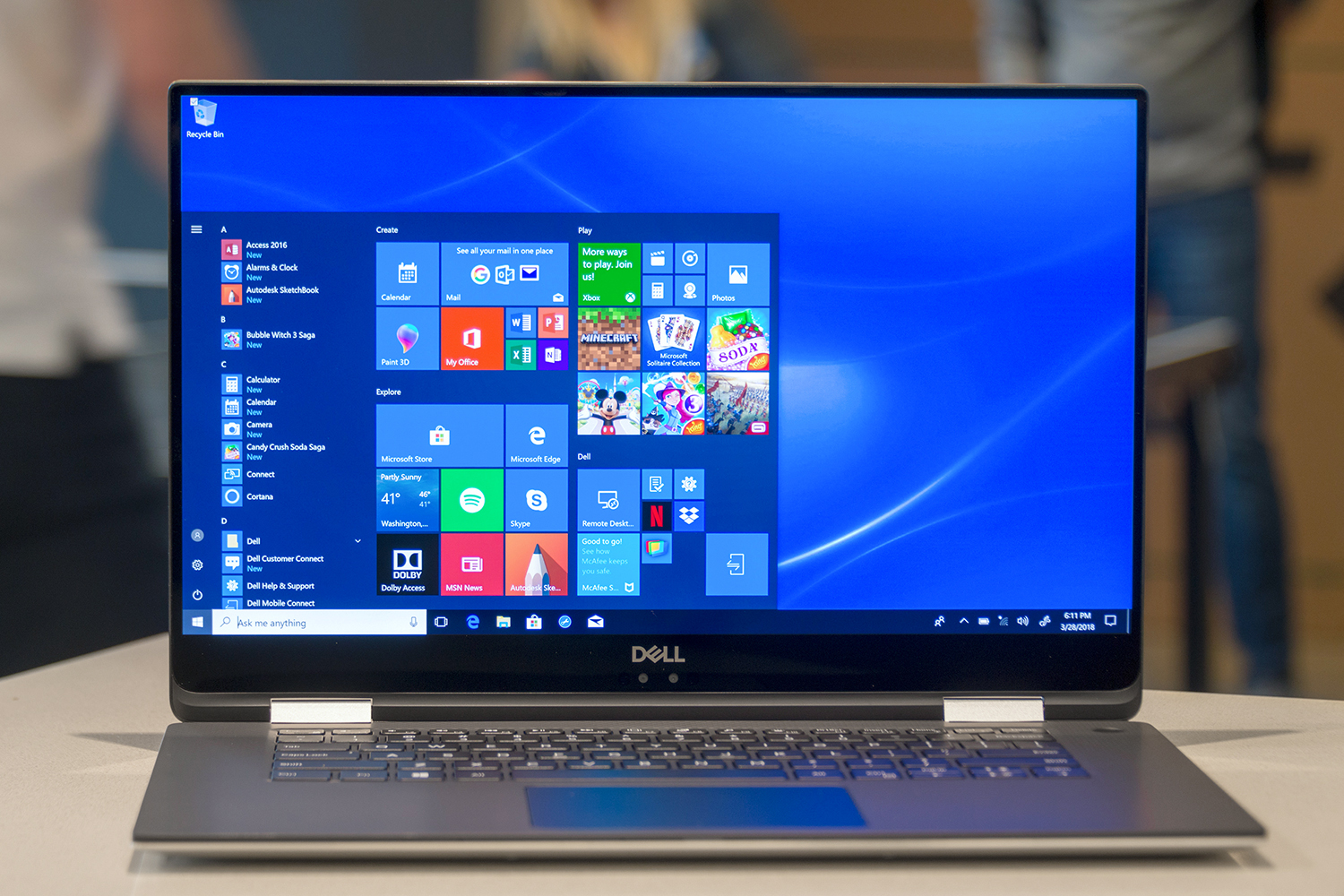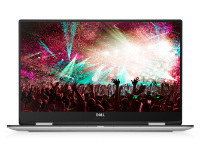
Microsoft’s Surface Book 2 represented the height of 2-in-1 innovation when it was introduced in October 2015. Since then, it’s gone through a few revisions and today’s Surface Book 2 maintains the innovative tear-off display while incorporating some seriously high-performance components.
Dell’s XPS 15 2-in-1 is also a highly innovative 2-in-1, and in fact Dell considers it to be essentially an experimental platform. Dell is innovating in different areas than Microsoft, however, making the XPS 15 2-in-1 a lot thinner and lighter and with a focus on controlling heat and managing the experience in a relatively tiny chassis.
Given that they’re both innovators, our Dell XPS 15 2-in-1 and Surface Book 2 15 showdown attempts to answer the question: Which machine’s idea of innovation results in the most usable 2-in-1?
|
Dell XPS 15 2-in-1 |
Surface Book 2 15 |
|
| Dimensions | 13.9 x 9.2 x 0.36-0.63 (in) | 13.5 x 9.87 x 0.568-0.90 (in) |
| Weight | Starting at 4.36 pounds | 15-inch starts at 4.2 pounds |
| Keyboard | Full-size backlit keyboard | Full-size backlit keyboard |
| Processor | Eighth-generation Intel Core i7-8705G | Eighth-generation Intel Core i7-8650U |
| RAM | Up to 16GB | 16GB |
| Graphics | AMD Radeon RX Vega M GL | Intel UHD 620 Nvidia GeForce GTX 1060 |
| Display | 15.6-inch IPS Display | 15.0-inch PixelSense Display |
| Resolution | Full HD (1,920 x 1,080, 141 PPI) 4K UHD (3,840 x 2,160, 282 PPI) |
3,240 x 2,160 (260 PPI) |
| Storage | Up to 1TB PCIe SSD | Up to 1TB PCIe SSD |
| Networking | 802.11ac, Bluetooth 4.1 | 802.11ac, Bluetooth 4.1 |
| Connectivity | USB-C with Thunderbolt 3 (x2), USB-C 3.1 (x2), 3.5mm combo jack | USB-A 3.0 (x2), USB-C 3.1, Surface Connect, SD card reader, 3.5mm combo jack, Xbox Wireless built-in |
| Webcam | 1080p webcam | 1080p webcam |
| Operating System | Windows 10 | Windows 10 |
| Battery | 75 watt-hour | 90 watt-hour |
| Price | $2,500+ | |
| Availability | Now (Microsoft Store) | |
| Review | 7.0 out of 10 stars | 8.0 out of 10 stars |
Design
Visually, the XPS 15 2-in-1 bears a striking resemblance to the smaller XPS 13 2-in-1 and to the rest of the XPS notebook line in general. That’s a good thing, because the combination of aluminum and black carbon fiber is conservative yet attractive — and it’s functionally pleasant as well with the soft-touch keyboard deck.
The XPS 15 2-in-1 is also incredibly thin, and in fact Dell calls it the “smallest, thinnest 2-in-1” in its 15-inch class at 0.63 inches. It’s also relatively light at 4.38 pounds, at least compared to most 15-inch 2-in-1s. Making a machine so thin that packs in such serious power (see the performance section below) required Dell to use some innovative materials to keep heat under control. Mainly, that meant enlisting space-age Gore material that sits in between the hot components and users’ skin to keep things tolerable.
For its own part, the Surface Book 2 15 also packs in some innovation. It’s in its third iteration without too much changing in its design or appearance, with the same silver-grey magnesium chassis with the unique fulcrum hinge the gap between the display and keyboard that you may or may not dislike. But it maintains its very different approach to the 2-in-1 format, where the display containing the actual PC tears off into a shockingly thin and light 15-inch tablet.
The entire unit remains relatively thick (0.9 inches at the hinge) compared to the XPS 15 2-in-1, but surprisingly its a bit lighter at 4.2 pounds. Thermal concerns aren’t quite so profound for the Surface Book 2, because unless you’re pushing the discrete GPU located in the machine’s base component, all of the heat is in the display and thus far away from a user’s skin when in clamshell mode.
Both machines are examples of the kind of innovation that pushes the market forward. We think that the Surface Book 2’s overall design remains both less compromising in a search for infinite thinness and yet it still makes for a better tablet experience — and that’s the crux of the 2-in-1 equation.
Winner: Surface Book 2 15
Performance
The Surface Book 2 15 is built around the fast and efficient eighth-generation Intel Core i7-8650U processor. That’s a speedy yet power-sipping 15-watt processor that can ramp up for higher-end productivity tasks and use significantly less power while running less demanding tasks. But the Surface Book 2 15 has a trick up its sleeve — it packs a legitimate gaming GPU, the Nvidia GeForce GTX 1060, into its base, making it a contender as both a serious 1080p gaming system and a hardcore video editing machine with the right software.
The XPS 15 2-in-1, on the other hand, utilizes the even newer Intel Kaby Lake-G processor, which is an eighth-generation quad-core processor coupled with an AMD Radeon RX Vega M GL GPU. That’s a combination that’s less about efficiency and more about pure performance, and compared to most other convertible 2-in-1s it’s a much more potent solution.
The XPS 15 2-in-1 competes well against the Surface Book 2 15 in terms of processor power. However, it falls short in graphical power compared to the GTX 1060 tucked away in Microsoft’s 2-in-1.
Winner: Surface Book 2 15
Keyboard, Mouse, and Pen
The Surface Book 2 is like most 2-in-1s in that it offers multiple ways to get information into the system. And it’s quite competent at doing so across the board, with an excellent keyboard offering copious amounts of travel (1.55mm) and a precise feel, and a Microsoft Precision touchpad that might very well be the best performer this side of a MacBook Pro. The newest Surface Pen is also a standout performer, with 4,096 levels of pressure sensitivity, tilt support, and unmatched responsiveness among Windows 2-in-1s.
Input is another area where Dell felt the need to come up with something unique thanks to the XPS 15 2-in-1’s incredibly svelte chassis. And the company’s response is a first-ever: a keyboard that uses magnetic levitation (maglev) to help overcome a short 0.7mm key travel that would normally result in a very shallow feel. We found the result to be snappy and loud with an abrupt bottoming action — whether it’s great or not will come down to personal tastes.
The XPS 15 2-in-1’s touchpad is a little more pedestrian and it’s also a good Microsoft Precision version with solid gesture support (although we noted that the buttons were a little loose resulting in some unintended clicks). The Dell Premium Active Pen also enjoys 4,096 levels of pressure sensitivity and tilt support, and it even attaches magnetically to the notebook just like with the Surface Book 2.
These two 2-in-1s are mostly equally matched, even down to supporting Windows 10 Hello (the Microsoft with an infrared camera and the Dell with a fingerprint scanner located in the power button). However, although we laud Dell’s use of cool technology with the maglev keyboard, the Surface Book 2 15’s keyboard is just a better experience. Microsoft takes this round as well.
Winner: Surface Book 2 15
Connectivity
With the Surface Book 2, Microsoft finally embraced USB-C. However, the company still didn’t pack in Thunderbolt 3 support, making it more limited in terms of things like display and external GPU support. There are also two USB-A 3.0 ports, a Surface Connect port, an SD card reader, and a 3.5mm combo jack. That’s all you get to go along with the usual 802.11ac Wi-Fi and Bluetooth radios.
With the XPS 15 2-in-1, Dell is all-in on USB-C — the machine has four of them, in fact. Two support Thunderbolt 3 with a full four lanes of PCIe, meaning that you’ll be able to plug in an array of displays and connect to an external GPU if the AMD Radeon RX Vega graphics are insufficient. Add in a headset jack, Wi-Fi, and Bluetooth, and that covers connectivity.
While Microsoft gets points for legacy USB-A support, the lack of Thunderbolt 3 is a weakness. Dell wins this one.
Winner: Dell XPS 15 2-in-1
Display

Both of these 2-in-1s pack in beautiful displays. However, they take different routes in getting there.
The Surface Book 2 offers a 15-inch display that utilizes the excellent-for-productivity 3:2 aspect ratio that’s taller and shows more vertical data at once. It’s also pin-sharp at 3,240 x 2,160 (260 PPI) resolution with awesome contrast and brightness that lends real depth to text and graphics. It doesn’t have terribly wide color gamut or great color accuracy, though, and so its better for number crunchers and writers than it is for photo editors.
Dell offers two display options, a Full HD (1,920 x 1,080 or 141 PPI) display and a 4K UHD (3,840 x 2,160 or 282 PPI) panel. We tested the latter in our review unit, and found it to be one of the best displays we’ve ever experienced in a notebook, hands-down. It offers a wide color gamut (96 percent of AdobeRGB), excellent brightness, and class-leading contrast, with awesome sharpness that’s made for Netflix 4K binging. Only its color accuracy is average.
Usually, Surface machines win the display category. Not this time — while the Surface Book 2 has a lovely display that beats most competitors, it can’t keep up with the XPS 15 2-in-1.
Winner: Dell XPS 15 2-in-1
Portability and Battery Life
The XPS 15 2-in-1 is significantly thinner and smaller than the Surface Book 2 15, and so it has that in its favor. And it’s within a couple of ounces of the Surface Book 2 in terms of overall weight. That makes it easier to toss into a backpack and carry around from workplace to workplace. It’s not as good as a tablet compared to the Surface Book 2 15’s tear-off display, but that’s true of all 360-degree convertible 2-in-1s.
However, the Surface Book 2 packs in 90 watt-hours of battery compared to XPS 15 2-in-1’s 75 watt-hours. And, Microsoft’s 2-in-1 uses the highly efficient U-series Intel Core processor with its lightweight integrated GPU. Apparently, it sips power compared to the Intel Core “G” processor in the XPS 15 2-in-1, because the Surface Book 2 15 simply blows the Dell away in terms of battery life.
In each of our battery tests, the XPS 15 2-in-1 performed poorly. It lasted for just over two hours in our Basemark test, compared to the Surface Book 2 15’s almost seven hours. It lasted for around four and a half hours browsing the web, compared to Microsoft’s almost 16 hours. And the Dell couldn’t even manage six hours looping a local video, whereas the Surface Book 2 15 lasted for over 20.5 hours.
We like svelte chassis in our notebooks, but battery life matters too. The XPS 15 2-in-1 just doesn’t have enough battery capacity to match its high-powered components, and Microsoft simply blows Dell out of the water in this category.
Winner: Surface Book 2 15
Availability and Price
The Surface Book 2 15 usually loses in price comparisons, unless it’s being compared to Apple’s MacBook Pro. It starts out relatively high, at $2,500 for a Core i7-8650U, 8GB of RAM, and a 256GB SSD, and goes all the way up from there. At its most expensive, it’s a stratospheric $3,300 for all of the same components except for a 1TB SSD. That’s a lot of money, which you’re paying for the powerful components and the ability to tear off the display.
The XPS 15 2-in-1 is also firmly in premium territory, although it doesn’t scale up quite as high as the Surface Book 2 15. It starts at $1,300 for an Intel Core i5-8305G (which sports the same AMD graphics), 8GB of RAM, a GB 128GB SSD, and a Full HD display. At the high end, you’ll spend $2,750 for an Intel Core i7-8705G, 16GB of RAM, a 1TB SSD, and that luscious 4K UHD panel.
These are both expensive machines, but Microsoft’s pricing is out of this world. At its lowest configuration, the XPS 15 2-in-1 qualifies as a cheap way to get some decent gaming performance.
Winner: Dell XPS 15 2-in-1
The Surface Book 2 takes the prize for its better performance and battery life

These are two seriously innovative and high-powered 2-in-1 notebooks. We like both of them, sometimes for very different reasons, but it’s undenable that they’re both good looking, fast, and fun to use.
However, Microsoft simply packed in faster components, at least for gamers and creative types that can use that GTX 1060 GPU, and the Surface Book 2 15’s battery life puts the XPS 15 2-in-1’s longevity to shame. More power and better battery life? We’ll take it. And when we want to use our 2-in-1 as a tablet, Microsoft’s design wins then, as well.





